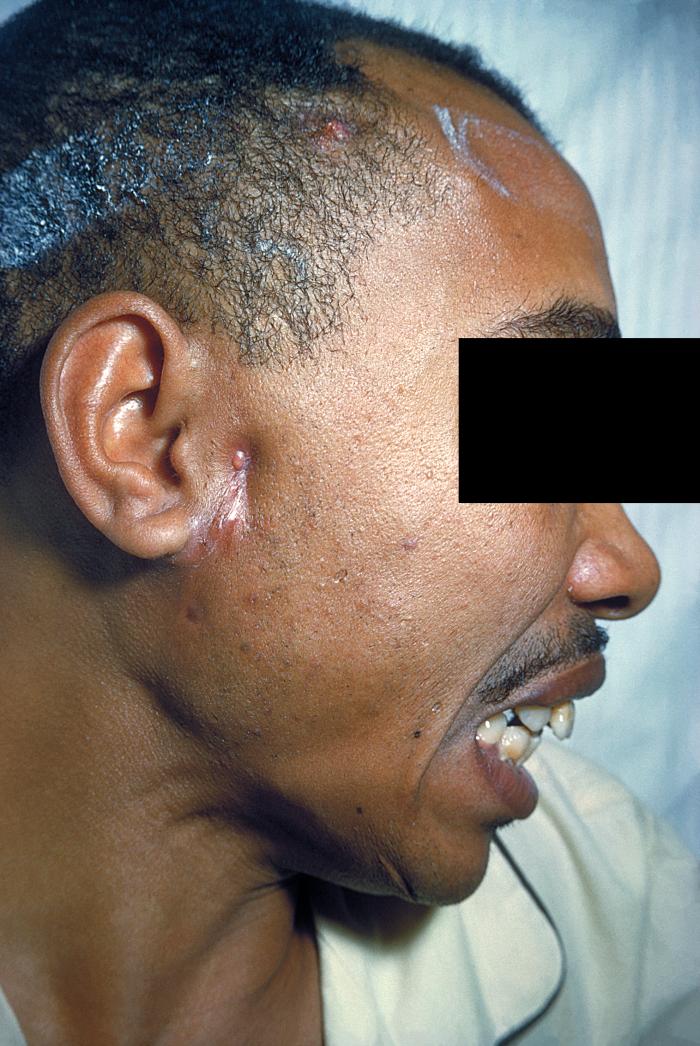WBR0056
Jump to navigation
Jump to search
| Author | PageAuthor::William J Gibson (Reviewed by Yazan Daaboul) |
|---|---|
| Exam Type | ExamType::USMLE Step 1 |
| Main Category | MainCategory::Microbiology |
| Sub Category | SubCategory::General Principles, SubCategory::Infectious Disease |
| Prompt | [[Prompt::A 35-year-old homeless man presents to his primary care physician for a right facial lesion that has developed slowly over the past six months. The lesion forms a sinus tract due to its ability to cross tissue planes. On closer inspection, the physician notices yellow "sulfur" granules within the lesion. Physical exam is otherwise remarkable for poor dentition and a lack of lymphadenopathy. The physician prescribes an antibiotic to treat the patient's condition. What is the most likely mechanism of action of the prescribed antibiotic? |
| Answer A | AnswerA::Inhibition of attachment of aminoacyl-tRNA |
| Answer A Explanation | [[AnswerAExp::Tetracyclines are bacteriostatic antibiotics that bind to 30S and inhibit the attachment of aminoacyl t-RNA. They may be used in lyme disease, C. trachomatis, and M. pneumoniae infections.]] |
| Answer B | AnswerB::Inhibition of cell wall peptidoglycan formation by binding D-ala D-ala |
| Answer B Explanation | [[AnswerBExp::Vancomycin may be used to treat gram-positive bacteria, including MRSA. Oral vancomycin is used to treat C. difficile colitis. It is not necessary in patients with A. israelii infection.]] |
| Answer C | AnswerC::Inhibition of initiation complex |
| Answer C Explanation | [[AnswerCExp::Aminoglycosides inhibit the formation of the initiation complex and cause misreading of mRNA. They are generally used to treat gram-negative infections.]] |
| Answer D | AnswerD::Blocking translocation by binding to 23S rRNA of 50S ribosomal subunit |
| Answer D Explanation | [[AnswerDExp::Macrolides are bacteriostatic antibiotics that inhibit protein synthesis by blocking translocation by binding to 23S rRNA of 50S ribosomal subunit. They are used as alternatives in patients with penicillin allergy and to treat atypical pneumonias and sexually transmitted infections.]] |
| Answer E | AnswerE::Inhibits cell wall synthesis by binding and inactivating proteins |
| Answer E Explanation | [[AnswerEExp::Penicillin is used to treat A. israelii infection. It binds penicillin-binding protein (PBP), blocks transpeptidase cross-linking of peptidoglycans, and activates autolytic enzymes. It is generally used to treat infections with some gram-positive rods and cocci, some gram-negative cocci syphilis.]] |
| Right Answer | RightAnswer::E |
| Explanation | [[Explanation::The patient is most probably diagnosed with Actinomyces israelii infection. Actinomyces israelii is a facultative gram-positive spore-forming anaerobic rod, part of the normal oral flora, and is able to cause disease only when it is free to replicate in an anoxic environment. It produces branching filaments that resemble fungal hyphae. Patients have often recently had dental work, poor oral hygiene, periodontal disease, or radiation therapy causing local tissue damage to the oral mucosa, all of which predispose to developing actinomycosis. Infection often presents as a penetrating lesion that forms a sinus tract (a new, pathologic path from the skin surface into the body), presence of a characteristic "lumpy jaw" appearance, and absence of lymphadenopathy. Microscopically, Actinomyces israelii is a species of gram-positive rod-shaped bacteria that forms yellow "sulfur" granules.
The optimal antibiotic for patients with Actinomyces israelii is penicillin, a β-lactam antibiotic that binds penicillin-binding protein (PBP), blocks transpeptidase cross-linking of peptidoglycan, and activates autolytic enzymes. |
| Approved | Approved::Yes |
| Keyword | WBRKeyword::Microbiology, WBRKeyword::Bacteria, WBRKeyword::Actinomyces, WBRKeyword::Abscess, WBRKeyword::Dermatology, WBRKeyword::Actinomyces, WBRKeyword::israelli, WBRKeyword::Infection, WBRKeyword::lumpy, WBRKeyword::jaw, WBRKeyword::sulfur, WBRKeyword::granule, WBRKeyword::granules |
| Linked Question | Linked:: |
| Order in Linked Questions | LinkedOrder:: |
